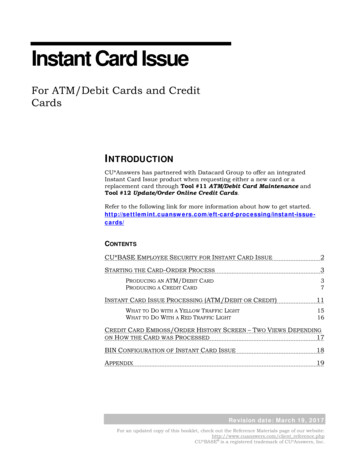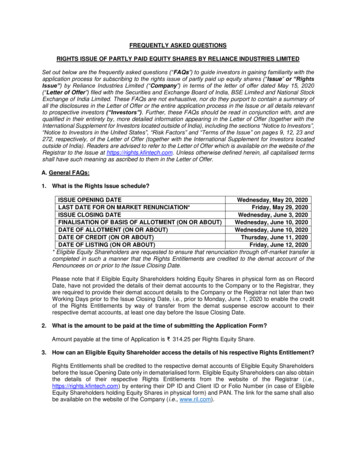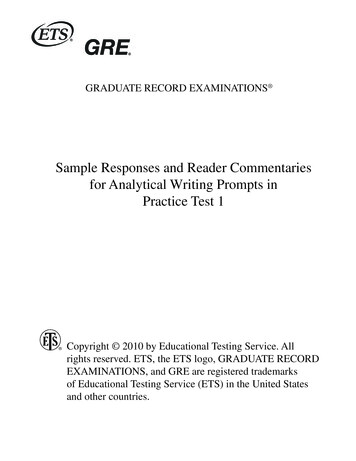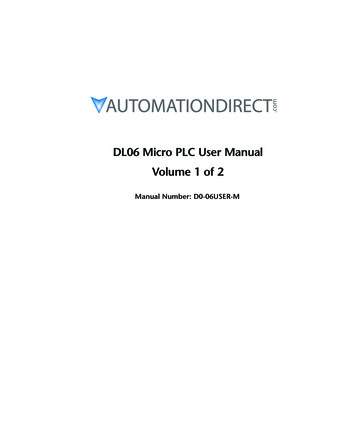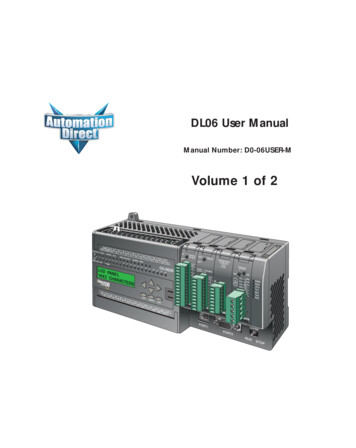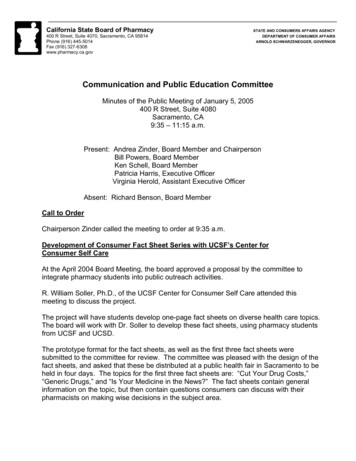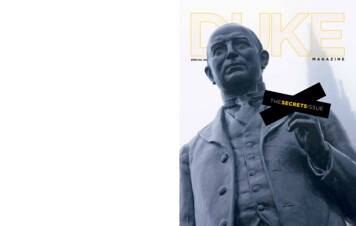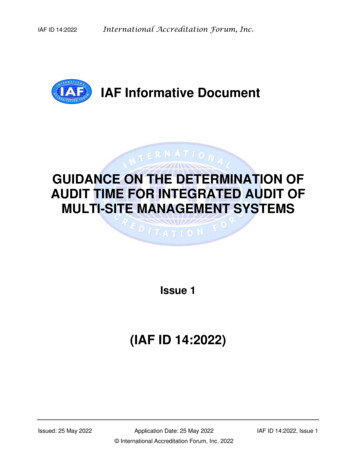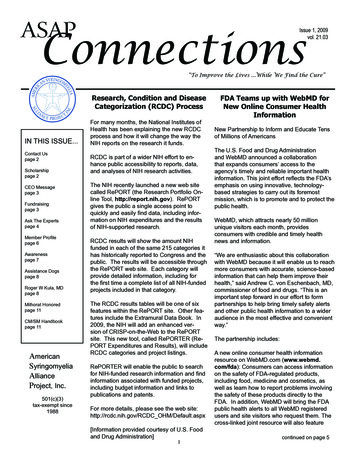
Transcription
ASAPConnectionsIssue 1, 2009vol. 21.03“To Improve the Lives .While We Find the Cure”Research, Condition and DiseaseCategorization (RCDC) ProcessIN THIS ISSUE.Contact Uspage 2Scholarshippage 2CEO Messagepage 3Fundraisingpage 3Ask The Expertspage 4Member Profilepage 6Awarenesspage 7Assistance Dogspage 8Roger W Kula, MDpage 8Milhorat Honoredpage 11CM/SM Handbookpage 11AmericanSyringomyeliaAllianceProject, Inc.501(c)(3)tax-exempt since1988For many months, the National Institutes ofHealth has been explaining the new RCDCprocess and how it will change the way theNIH reports on the research it funds.RCDC is part of a wider NIH effort to enhance public accessibility to reports, data,and analyses of NIH research activities.The NIH recently launched a new web sitecalled RePORT (the Research Portfolio Online Tool, http://report.nih.gov). RePORTgives the public a single access point toquickly and easily find data, including information on NIH expenditures and the resultsof NIH-supported research.RCDC results will show the amount NIHfunded in each of the same 215 categories ithas historically reported to Congress and thepublic. The results will be accessible throughthe RePORT web site. Each category willprovide detailed information, including forthe first time a complete list of all NIH-fundedprojects included in that category.The RCDC results tables will be one of sixfeatures within the RePORT site. Other features include the Extramural Data Book. In2009, the NIH will add an enhanced version of CRISP-on-the-Web to the RePORTsite. This new tool, called RePORTER (RePORT Expenditures and Results), will includeRCDC categories and project listings.RePORTER will enable the public to searchfor NIH-funded research information and findinformation associated with funded projects,including budget information and links topublications and patents.For more details, please see the web site:http://rcdc.nih.gov/RCDC OHM/Default.aspx[Information provided courtesy of U.S. Foodand Drug Administration]1FDA Teams up with WebMD forNew Online Consumer HealthInformationNew Partnership to Inform and Educate Tensof Millions of AmericansThe U.S. Food and Drug Administrationand WebMD announced a collaborationthat expands consumers’ access to theagency’s timely and reliable important healthinformation. This joint effort reflects the FDA’semphasis on using innovative, technologybased strategies to carry out its foremostmission, which is to promote and to protect thepublic health.WebMD, which attracts nearly 50 millionunique visitors each month, providesconsumers with credible and timely healthnews and information.“We are enthusiastic about this collaborationwith WebMD because it will enable us to reachmore consumers with accurate, science-basedinformation that can help them improve theirhealth,” said Andrew C. von Eschenbach, MD,commissioner of food and drugs. “This is animportant step forward in our effort to formpartnerships to help bring timely safety alertsand other public health information to a wideraudience in the most effective and convenientway.”The partnership includes:A new online consumer health informationresource on WebMD.com (www.webmd.com/fda): Consumers can access informationon the safety of FDA-regulated products,including food, medicine and cosmetics, aswell as learn how to report problems involvingthe safety of these products directly to theFDA. In addition, WebMD will bring the FDApublic health alerts to all WebMD registeredusers and site visitors who request them. Thecross-linked joint resource will also featurecontinued on page 5
ASAPContact UsBobby Jones Open College Scholarshipby Patricia MaxwellThrough various programs the Bobby Jones Open (BJO)has partnered with ASAP for over 18 years to improvethe lives of persons affected by syringomyelia, Chiarimalformation and related disorders The BJO CollegeScholarship has assisted ASAP members with theireducation since 2003. During that time 15 students havereceived 37,000 in financial aid.ASAPAmerican Syringomyelia Alliance Project, Inc.Address:300 North Green Street, Suite 412Longview, Texas 00-272-7282This year’s recipients chosen from 20 applicationsinclude one new and four renewal students: CaitlinSevigny, Shellee Syrewicze, Melissa Murray, JamieRose and Shauna Sedler. All are full time studentsattending colleges in either Michigan, Maine, Missourior Massachusetts. The application process is opento people diagnosed with syringomyelia or Chiarimalformation or have a parent with the disorder and whoare members of ASAP for at least six months beforeapplying.Staff: Patricia Maxwell & Jamie MayhanEmail:info@ASAP.orgPatricia Maxwell@ASAP.orgJamie Mayhan@ASAP.orgAddress:50 Biscayne Drive NW, Suite 3104Atlanta, Georgia 30309-1042Phone:404-889-2055Email:Dick Hellner@ASAP.orgNew applications must be received January 15 throughMay 15. The renewal applications period is May 15through June 15. Students must provide medicalcertification of his/her or parent’s diagnosis. Othercriteria include a completed application form, essay andfinancial information. Those interested in learning moreabout the scholarship can download the application andinformational brochure at www.ASAP.org or contact theASAP office.Chief Executive Officer: Richard T. HellnerTo insure fairness in the ranking of the applications,the BJO has chosen College Foundation, Inc, (CFI) toreview all applications. CFI is an independent nonprofitorganization dedicated to helping students achieve theircollege goals. All applications will be mailed directly toCFI. Your confidentiality is important to us and CFI willuse reasonable safeguards to protect the informationsubmitted.ASAP Outreach Telephone SeminarMarch 17, 20098:00 PM EasternDue to the death of Robert A Jones there were a fewproblems with the scholarship process in 2008. RobertD Jones, president of the BJO, is working hard to correctthese issues and alleviate them in the future. We aregrateful for the continued support of the Bobby JonesOpen.Free one-hour presentation featuring keynote speaker:Diane Mueller, PhDThinking about having a baby? Women with Chiari malformation and syringomyelia have special concerns andquestions about pregnancy. You will not want to miss thisspecial presentation.Please Note: Articles in this newsletter are notintended as a substitute for medical advice and donot necessarily represent the viewpoints of the editor,Medical Advisory Board or Board of Directors. Pleasecontact your doctor before engaging in any newtherapy or medication.To take part in this Outreach Telephone Seminar registeronline http://www.asap.org/2008/teleconference.htmlor call the Longview business office.2
A Word from Our CEOThe Art of FundraisingVoluntarism – A Key Growth StrategyOne of the top strategies to develop therevenue needed to help ASAP fulfill itsmission of service to the SM and CMcommunity is the work that members doto organize and conduct local fundraisingevents. A strong additional benefit to theseactivities is the development of local name recognition andpublic education about these conditions.by Dick Hellnerby Arnie HulteenHow do many small and mid-sizenonprofits effectively pursue theirmissions and expand their serviceprograms to help more people? How dothey keep operating expenses low and compete favorablywith larger charities in dedicating more resources to thosewho need their help? Among the number of techniquesused, one stands out above all others – voluntarism.Especially in this time of financial uncertainty, anything thatcommunity members can do to support each other locallyand help others around the country through ASAP’s vitalprograms will help all of us endure this unsettling period.While the winter and early spring are generally not amenable to some kinds of events, many others can be conductedwith exceptionally good results. Here are some suggestionsthat will hopefully spur you, your family and your communityto help throughout this economically challenging near-termfuture.Voluntarism is defined as the principle or practice of usingthe collective, coordinated work of people who freely givetheir time without financial compensation to accomplish aworthwhile goal, usually helping others in the community.Starting with its founders, Don and Barbara White, ASAPhas a long, twenty-year history of successfully turning thegenerous gifts of time and talent of members to help theorganization meet the needs of the growing SM and CMcommunity. Today’s volunteers stand on the shoulders ofthe many selfless men and women who came before themin building this effective organization.Dinner DancesCostume Balls: Pick a theme that blends with your organization and have a “ball.” From movie themes to songs oreven your role model, this gets donors dressed and readyfor fun.Today, while we enjoy the efforts of many wonderfulvolunteers, more are desperately needed: To help current volunteers and guard against burnout To further minimize cost to make up for diminishedgiving in an uncertain economy To respond to new challenges and opportunities To add a broader level of talent and experienceFashion Shows: Partner with one or more clothing retailers in your community. In addition to the revenue producedthrough ticket sales, this is a wonderful live auction opportunity to offer the merchandise of the sponsoring clothingretailers and others.Please consider completing the volunteer form whichyou will find as an insert in this newsletter. Mail it to ourLongview, TX office. The form is also available on our website: hand Rose Show: Use items from your local thriftstore or combine with another local charity that has a thriftstore and split the profits.Events for the Whole FamilyThank you!Walk-A-Thons / Pet Walks: Start and end the walk in theparking lot of your local newspaper and you can gain extrapublicity by teaming up with the media. If expenses allow,have a tent with vendors, kid’s activities and other streetfair type events and create a full day of fun and great exposure for ASAP. You could purchase items through ASAP’sweb site and sell them at a higher cost to benefit ASAP, i.e.,ASAP mugs, tee shirts, Christmas cards and the like. Don’tforget to have a booth/table to include ASAP materials thathelp explain ASAP’s mission. Give donors a way to donatethrough brochures, remittance envelopes and most importantly, display ASAP’s web address for more information.You Asked We ListenedASAP has developed a convenient way to makeperiodic donations to help all those who are affectedby CM and SM. Visit the donations page on ourweb site www.ASAP.org and choose from amongthe various options including monthly, bimonthlyand quarterly. It’s that simple; the rest is doneautomatically unless or until you decide to make achange.Other A-Thons: Walk, climb, dance, cut hair, read books,ride bikes, call, ride horses, fishing competitions or do acontinued on page 93
Ask The ExpertsQuestion and Answer - Scolosis and Tethered Cordand we just don’t know the answer.We’re not taking either side; we’re justtrying to get the current data out there.Question: When my daughter was three she had a37 scoliosis, Chiari and syringomyelia. She had twodecompressions, the second one worked. Every year herscoliosis got 10 better and got down to 15 . Then, thisyear it went up to 22 . I was told to look into tethered cordthat may be causing the scoliosis. Is it better to untetherthe spinal cord when you are young? If it’s not tetheredcord what else could it be?Dr. Oró: I think what Dr. Ellenbogen isreferring to in terms of the Oregon neurosurgeon is thatthese are children who have lost bladder control at school.It’s not a Chiari or syringomyelia issue, but there is thisgroup of young children who are wetting themselves atschool who seem to be responding to this procedure.Dr. Oró: We need to talk about a variety of possibilities.Looking at the syrinx, is it persistent and why? But there isa new concept that I think we’ll hear more about concerningtethered cord, even though your spinal cord ends in anormal position. The classic hidden tethered cord meantthat your spinal cord was held down at the bottom of yourspine. As you grow, your spine grows more than thenerves and spinal cord. The spinal cord actually moves upas we get older and that’s in part answer to the question ofwhy tethered cord might occur later on in life.Dr. Ellenbogen: Yes, that’s correct.Dr. Oró: The other thing is that there are a growing numberof people who have had release of tethered cord in thenormal position. In them it made a big change in their life.I agree with Dr. Ellenbogen, we need some hard evidenceguiding us as to who will respond and who wouldn’t.Dr. Ellenbogen: I totally agree. It’s like a lot of things inmedicine. We can give a simple drug for a lot of diseasesand only a certain percentage of people are going to getbetter; nothing works 100% for everybody.There is also a new challenging concept right now butwe don’t have enough solid information to talk about ityet. It appears that surgeons from Barcelona, Spain werethe first to make this observation. In a study of twentypatients, some with syringomyelia, some with syringomyeliaand Chiari they released the spinal cord, even thoughit was in the normal position. How do you make thatdiagnosis? It’s not very easy to make if it’s a normal MRIscan. Unfortunately, there’s a lot lacking in the report. It’svery pioneering work, but it’s not very thorough. Some ofthese people had dramatic improvement in their neurologicsymptoms with snipping this band, even though the cordwas in the normal position. And it was also associatedwith scoliosis, bladder problems, numbness of the feet andsome people could not bend forward very well and touchtheir toes. I hope the people at the Chiari Institute will beable to tell us more about it because they probably havethe most experience so far.[Transcript from the 2007 ASAP Conference, Seattle, WA.Dr. Richard G. Ellenbogen is Professor of NeurologicalSurgery at the University of WashingtonDr. John J. Oró is a neurosurgeon experienced in thetreatment of Chiari I malformation. In 2005, he founded TheChiari Treatment Center in Aurora, Colorado ]Thank You, RichRichard Zimmer has been an active member of ASAPfor 20 years, serving our mission in multiple ways. Hisvaluable personal experience has been shared withothers through both the peer support program andconferences. In November 2004, he was elected to theBoard of Directors and re-elected to a second term in2007. However due to continuing health issues he foundit necessary to resign this position December 31, 2008.Dr. Ellenbogen: There’s a neurosurgeon in Portland,Oregon who does about 150 tethered cord releases ayear. I do about 50 a year. It is interesting that 80 milesaway there seems to be a higher incidence of this. To tellyou that we have answers is really quite false. It’s a hugecontroversy in neurological surgery that the spinal cord inthe normal position causes problems. If the spinal cordis low lying, we do know that if you snip it, which is fairlysafe with younger patients, they won’t go on to developneurologic deficits. Most of the time it doesn’t retether.However if you wait until they get a neurologic deficit, theoutcome may not be as positive. For example, I had aten-year-old soccer player who lost the function of his leg.When we snipped the cord, he got better but he still had anumb leg. If you do it before there are problems, the resultis better. But untethering the spinal cord at the normal levelis still an extremely controversial subject that people debateJudy Hunt, ASAP President said, “I have been honoredto serve on the Board with Rich. His commitment torepresent ASAP members as a Director has been aninvaluable asset to this community.”As a Board member Rich fought for his peers andprograms to improve the lives of those affected bysyringomyelia and Chiari. We are grateful to Rich for hispassion, dedication, leadership and business experience.4
FDA Teams up with WebMDFDA Approves New Drug to AlleviateModerate to Severe Paincontinued from page 1FDA’s Consumer Updates—timely and easy-to-readarticles that are also posted on the FDA’s main consumerweb page (www.fda.gov/consumer).The U.S. Food and Drug Administration has approvedTapentadol hydrochloride, an immediate-release oral tabletfor the relief of moderate to severe acute pain.FDA Consumer Updates will also be featured at leastthree times a year in WebMD’s bimonthly magazine, whichreaches nearly nine million consumers. The magazine isdistributed to physician office waiting rooms across thecountry.Tapentadol is a centrally-acting synthetic analgesic that isavailable in doses of 50 mg, 75 mg, or 100 mg.“This approval offers health care professionals anadditional choice for treating moderate to severe acutepain,” said John Jenkins, MD, director of the office ofnew drugs in the FDA’s Center for Drug Evaluation andResearch.“As a leading brand of health information, we are pleasedto be partnering with the FDA to provide consumerswith public health and safety information, direct from thesource,” says Wayne Gattinella, WebMD president andchief executive officer. “This important partnership isconsistent with WebMD’s longstanding mission of providingfor Americans access to credible and relevant healthinformation.”Tapentadol acts in two ways, opioid (narcotic) andnon-opioid. It affects the brain and body primarily byactivating opioid receptors in the brain, spinal cord andgastrointestinal tract. In addition, Tapentadol inhibits thereuptake of the brain chemical norepinephrine whichpossibly has an analgesic effect.Consumers have increasingly consulted all types ofsources to find health information, and the Internet is theirfastest growing resource, according to a national studyreleased in August 2008 by the Center for Studying HealthSystem Change. Researchers found that 32 percent ofAmerican consumers—70 million adults—conducted onlinehealth searches in 2007, compared with 16 percent in2001.Acute pain is a symptom of many medical conditions andcan significantly interfere with a person’s quality of lifeand general functioning. Opioids are considered safe andeffective in selected patients but can cause dependence,abuse, and addiction. All patients treated with opioidsrequire careful monitoring by their health care professionalfor signs of abuse and addiction, and to determine whenopioid analgesics are no longer needed.The study also found that most consumers who researchedhealth concerns reported positive outcomes. More thanhalf of those surveyed said the information changed theiroverall approach to maintaining their health. Four in fivesaid the information helped them better understand how totreat an illness or condition.The most common side effects from Tapentadol arenausea, dizziness, vomiting, and sleepiness. The labelingfor Tapentadol includes warnings about the risk ofrespiratory depression; addictive depressive effects onthe central nervous system when taken with alcohol, otheropioids, or illicit drugs; and abuse potential.The complete terms and components of the partnershipare described in a Memorandum of Understanding whichis available online at display.cfmTapentadol is manufactured by Janssen Ortho, LLC,Gurabo, PR.[Information provided courtesy of U.S. Food and DrugAdministration][Information provided courtesy of U.S. Food and DrugAdministration][Editor’s Note: The information found in this newslettershould not be used as a substitute for medical advice froma certified medical professional. It is provided purely forinformative purposes.]Save the Date2009 Annual ConferenceJuly 15 - 18www.ASAP.orgSheraton Madison HotelMadison, Wisconsin1-800-ASAP-2825
Member Profileby Patricia MaxwellSara desperately wanted to raiseawareness about the disorderher daughter battles daily. Afterbrainstorming with Arnie Hulteen, ASAPChief Development Officer, an idea beganto take form. Working with a family friendwho owns a print shop, they designeda banner which now hangs in front ofher store. It wasn’t long before an old friend driving pastnoticed the sign. She had just been diagnosed andcouldn’t believe what she was seeing. Sara was able tohelp her friend skip all the disappointing doctor visits bysharing her information and experience.Every morning hundreds of children wakeup with a pounding headache. Theysit on the sidelines as they watch theirfriends, unable to participate due to painand fatigue. Parents, seeking answers,make numerous appointments withthe pediatrician. Sometimes told it is psychosomatic ortemporary, they are left to their own devices and the Internetto find answers. A scenario played out far too often—ASAP members are discovering creative ways to combatthe isolation and reach the public with our mission. This isCathleen’s story.It is not easy keeping Cathleen’s life normal. A 504 planis in effect at school that allows her to have two sets ofbooks —one in the classroom and one at home. She isexcluded from certain gym activities and is not allowed tolift more than 15 pounds. Cathleen and her family havefaced multiple challenges in the last two years and theyrealize it is only the beginning.An adventurous nine-year-old, Cathleen loves softball andswimming, collects snow globes, excels in math, and wouldprefer spelling was dropped from the classroom agenda.She looks forward to one day playing the trombone in thehigh school band. But unlike her friends, she lives withchronic pain. The family doctor was determined to find thecause of her symptoms but it was a rocky road. After visitsto multiple physicians, an MRI finally revealed the answer:Chiari malformation. The family was relieved but still in thedark. Like most, they had never heard of this disorder.Sara knows that awareness is the key to finding acure and will continue her endeavors toward that end.The family has taken their sign to local support groupmeetings. Sara is having magnetic awareness ribbonsmade to sell as a fundraiser. Gabriella, Cathleen’s oldersister, published an article for the local newspaper aboutthe struggles the family is facing and what they are doingto overcome them. The family battles daily to maintaina positive attitude. They believe the key component toemotional stability is a strong family foundation and areworking together to provide Cathleen with a safe haven.SYRI NGOANMICLIYEAAMERCathleen’s mother, Sara, spends hours searching the web.She credits the ASAP message board with helping her tofind a specialist that has been able to answer many of herquestions. She has shared this information with others whohave also been diagnosed in her small town. She is helpingothers to bypass the months and years of searching forhelp.LNCNCALIAE P RO J E CTIFlorida Dad Turns Hobby into Fulltime Fundraiserby Patricia MaxwellWorking Toward a Cure 20,000 before she graduates from high school. Withhelp from their family and friends they have held severalannual yard sales, sold hand-made bracelets, addressedcommunity organizations, manned booths at local tradeshows, and held fundraisers at their school.Stuart enjoys tying flies almost as much as he enjoys flyfishing. So he decided to turn his tying interests into arevenue stream for syringomyelia and Chiari malformationresearch. His twin daughters Hope and Holly suffer fromseveral neurological conditions including syringomyelia,Chiari malformation, intracranial hypertension and chronicpain, disorders that have caused stress in the family’s livesbut also brought out strength, love and courage.Proud of his girls’ efforts and wanting to help themreach their goal, Stuart designed a web site to sell hisold Florida flies. Patterson Saltwater Flies donates allnet proceeds from the sale of merchandise to researchthrough the American Syringomyelia Alliance Project.A few years ago Holly decided not to sit idly by and allowher condition to determine her future. Hope was in fullsupport, excited and energetic. The girls decided to raisemoney to fund medical research. Holly’s goal is to raiseFor more information about Stuart’s endeavor visitwww.pattersonsaltwaterflies.com6
Awareness and FundraisingSpaghetti Dinnerprovided by Christine Marchessanoevent which was attended by over 300 people included alive raffle and auction consisting of over 120 items. WhenChristine started to reach out to the community in late June,slowly but steadily the donations grew.On October 3 the South Jersey Chiari Awareness Initiative hosted the first annual spaghetti dinner and auction,which successfully brought much needed awareness to theLittle Egg Harbor community. Although this was ChristineMarchesano’s first endeavor, she raised 4,000 for ASAP.Planning for the event which began in April helped Christineto learn firsthand how to reach out to her community forsupport in order to turn her dream into a reality.The highlight of the evening came when AssemblymanBrian Rumpf presented Christine with the New Jersey stateproclamation that will be introduced to the legislature inTrenton. This is an effort to establish Chiari legislative billsthat will address many issues pertaining to the disorder.Christine was excited to learn that from now on, April 10has been declared as Chiari Awareness Day in Little EggHarbor, New Jersey.Her incentive was very personal. Christine said, “Raisingawareness about Chiari I, cranial settling and EDS andputting all my energy into an organized function, made itpossible for me to feel vindicated. Even with physical limitations, I conquered and survived.” When Christine acted ona nagging thought to get up and do something, she wrotea letter to the township committee and Mayor Scott Stitesabout others living with Chiari malformation and the necessity to raise awareness in the community.The Tidal Wave Band of South Jersey donated their timeand talent providing the entertainment for the evening.Christine has been a follower of the band since 2005,developing a close friendship with its members. They werethere for her before she became ill, when she was firstdiagnosed and offered their support when she underwentsurgery. Pictures from the spaghetti dinner can be viewedon the band’s web site: www.tidalwaveband.com/chiari/chiarihome.htmlAs a result, she received a phone call from Deputy MayorJohn Kehm, who was also the chief Masonic Lodge brother.He offered to do a fundraiser for the cause. She jumped onthe idea and together they decided to organize a spaghettidinner. Christine said, “The Masonic Lodge of Tuckerton,NJ, is made up of pretty amazing people who make thingshappen and have a passion for helping others. They alsoknow how to have fun.”Christine credits Patrice Schaublin for providing the expertise to transform her ideas into a successful event. Shewould also like to thank Mark McKairnes, Arnie Hulteen,Ellie McCallum and Jamie Mayhan for their assistance.Special thanks to the Masonic Lodge and many other volunteers who live in the LEH community. Additional recognition is extended to the following companies that donatedthe food and drink—BJ’s, Shoprite, Costco, ACME, Bruno’sMeat Market, Shopping Bag and Sea Oakes Country Club.SYRI NGOANMICLIYEAAMERIt was a night of celebration, fun, hope, community, discovery, awareness, and reality all wrapped into one. TheLIANCNCALWalk-a-thonby Candy ReinertE P RO J E CTImaking 65 soft travel pillows and “Thinking about you”cards for Chiari patients having surgery at North ShoreUniversity Hospital. The manager from Funland (aninflatable play area in the mall) even opened an hour earlyat no cost, to let the little ones bounce off some of thecotton candy they had for breakfast.In September, The Chiari People of PA support groupheld a Walk For a Cure and Awareness event in Reading,PA. The mall was the perfect location, sheltering theparticipants from the weather. ASAP CEO Dick Hellnerand Board member Patrice Schaublin were on handto open the event. It was a special time for everyoneinvolved. Events like this give us all hope ‑ hope in eachother, hope in our community and hope that together wecan make a difference.All in all everybody went away with a new appreciation forwhat it is like to live with Chiari and syringomyelia. Theygot a glimpse into the pain that we feel every day whilechecking out our Art of Pain wall. Families became closerand new friends were made. Most importantly they put us astep closer to finding a cure and learning how they can helpspread the word. Each single voice can be a choir for ourcause. We look forward to seeing more of you attend nextyear.Approximately 120 friends and family came together tolearn more about Chiari and syringomyelia, while raisingfunds to be used toward research. The day was so muchmore than a walk. Along with it, the silent auction, raffles,a bake sale, and cotton candy sales, we raised closeto 6,000. The kids in attendance worked very hard on7
AZ Syringo Chiari Support GroupMeet the Medical Advisory BoardWe had a wonderful presentation from Power Paws at ourOct. 16th meeting. They covered all the different types ofservice dogs they train. We also were treated with a demonstration from two puppies in training. Quite impressive!Roger W. Kula, MD, completedmedical school in 1970 atThe Johns Hopkins UniversitySchool of Medicine in Baltimore,Maryland. He underwent hisinternal medicine training atThe New York Hospital-CornellMedical Center. His neurologytraining continued at the University of California Hospitals, San Francisco, where his exposure to the influence of then-chairman Robert A. Fishman,MD, first stimulated his interest in spinal fluid physiology.He completed his formal residency training at the MedicalNeurology Branch of the National Institute of NeurologicalDiseases and Stroke, Bethesda, Maryland, in 1975, wherehe continued training in neuromuscular diseases under thementorship of W. King Engel, MD
the BJO has chosen College Foundation, Inc, (CFI) to review all applications. CFI is an independent nonprofit organization dedicated to helping students achieve their college goals. All applications will be mailed directly to CFI. Your confidentiality is important to us and CFI will use reasonable safeguards to protect the information submitted.

